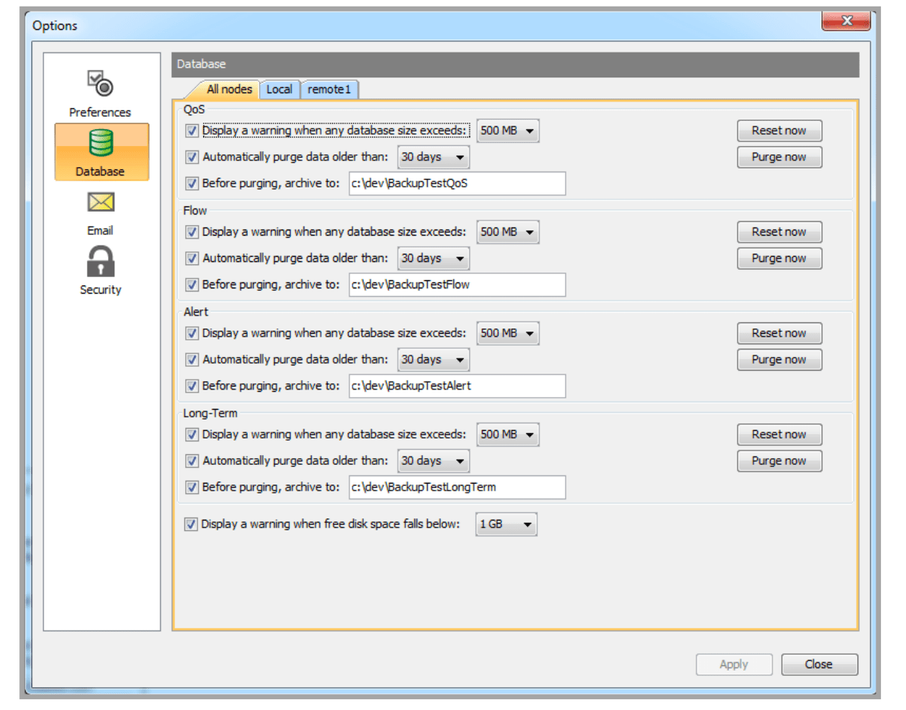Database
The Database section of the Options dialog allows you to manage settings related to the databases used by LiveNX. Database management can be completed on all Nodes including the LiveNX Server by using the All Nodes tab. Individual Nodes can be controlled by clicking on the corresponding Node tab.


All Nodes tab: Changes made in this tab will affect all Nodes in the LiveNX system. LiveNX generates four databases: QoS, Flow, Alert and Long-Term. Each database can be configured across all Nodes to:
• Enable a warning when the database exceeds either 500 MB, 1 GB, 2 GB, 5 GB, 10 GB, 50 GB, 100 GB or 500 GB. Default is warning = ON and size = 500 MB.
• Enable an automatic purge feature for data older than 1, 2, 5, 10, 30 or 60, 90, 120, 180 or 360 days. Default is auto-purge = ON and age = 10 days for the QoS, Flow and Alert databases and 365 days for the Long-Term database.
• To save database data before purging, click on the Before purging, archive to: check box. For example, to store the database data in the same directory as the LiveNX Server data, type C”LiveAction Server Data. • Reset a particular database (QoS, Flow, Alert or Long-term) across all Nodes by clicking on the Reset now button. This will erase all data collected in that database.
• Purge a particular database (QoS, Flow, Alert or Long-term) across all Nodes by clicking on the Purge now button. This will erase all data older than the specified duration selected in the drop-down menu.
• Enable a warning when the free disk space on any Node exceeds either 1 GB, 10 GB, 20 GB, 30GB, 50 GB or 100 GB. Default is warning = ON and size = 1 GB.
NOTE: LiveNX supports an automatic purge to ensure that there is sufficient space to store about one minute worth of SNMP, Flow, Alert and Long-term data. This is not user-configurable, but the auto-purging of the four databases are done only as a last resort, to ensure that there is sufficient space to store the most recent data.
Individual NTab: Although the default is to use the All Nodes configuration, each Node’s database may be configured separately by unchecking the Use All Nodes Config check box and selecting the individual tab for the desired Node. In addition to displaying the Volume size and Volume size free for the individual Node, each database within that Node can be configured to:
• Backup an individual database by clicking on the Backup now button—This saves a copy of the database to a directory on the Node. After clicking on the Backup now button, LiveNX prompts you to specify the backup directory on the Server. To store the backup data in the same directory as the LiveNX Server data, type C: LiveAction Server Data. The backup QoS, Flow, Alert and Long-term databases will be stored in the location selected with the filenames Snap store, Flowstore, Alert store and longterm store, respectively, each appended with the backup creation time in the
• YYYY.MM.DD.HH.MM.SS format. If disk space is an issue, you are advised to move the backup files off-line and purge the local copy. The backup QoS, Flow and Alert database directories can be added back to LiveNX to analyze historical information by using the Mounted Data feature in the LiveNX Server console. Please see Mounting Data Directories into the LiveNX Server section of Chapter 2 – Installation. The Long-term Database cannot be mounted; replacement requires manually swapping the long-term databases out in the Flowstore-dashboard cache directory in the LiveNX Server Data directory.
• Reset a database (QoS, Flow, Alert or Long-term) on the individual Node by clicking on the corresponding Reset now button. This will erase all data collected in that database.
• Purge a particular database (QoS, Flow, Alert or Long-term) on the individual Node by clicking on the corresponding Purge now button. This will purge all data older than the specified duration selected in the drop-down menu in the All Nodes tab.